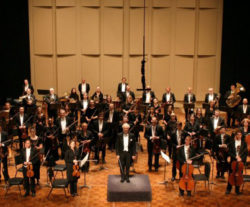Louisiana Philharmonic Orchestra
The Louisiana Philharmonic Orchestra is the only musician-owned and collaboratively managed full-time symphony orchestra in the United States.

Courtesy of Wikimedia Commons
Louisiana Philharmonic. Unknown
The Louisiana Philharmonic Orchestra (LPO), founded in 1991 by musicians of the defunct New Orleans Philharmonic Symphony Orchestra, is the only musician-owned and collaboratively managed full-time professional symphony orchestra in the United States. The LPO, consisting of sixty-seven full-time professional musicians, dedicates itself to maintaining live symphonic music and a full-scale symphonic orchestra as an integral part of the cultural and educational life of the New Orleans area, the state of Louisiana, and the Gulf South region. Starting as a musician-only organization, it slowly became more collaborative as staff was hired to fulfill critical administrative and fund-raising activities and community members were invited to join an expanded board of directors.
The LPO’s unique governance structure supports a fully collaborative partnership of its performing musicians, community representatives, and professional staff. The musicians, however, as the owner-members of the orchestra corporation, retain final oversight of all policies and governance.
In 1995, the LPO hired its first music director, Klauspeter Siebel, a noted German symphonic and opera conductor, who served until his retirement in 2004, when he accepted the position of permanent guest conductor. In 2005, the young Mexican conductor Carlos Miguel Prieto was appointed as the LPO’s second music director.
Since 2000, the LPO has performed concerts in an ever-expanding geographic area within Louisiana, including Orleans, Jefferson, St. Bernard, St. Tammany, and Tangipahoa parishes. Educational concerts now reach children in an even wider ten-parish area. The orchestra performs an average of 125 classic, spotlight, casual classics, family-oriented, and education concerts each year in settings as varied as public parks, churches, and university auditoriums.
In 2005, following the devastation of Hurricane Katrina, when numerous instruments, stands, and chairs, as well as the Orpheum Theatre which housed them, were destroyed, the LPO gathered its musicians from exile in cities across the United States and Canada to perform a limited number of concerts in New Orleans. They performed in public spaces as well as in a variety of churches.
In 2006, a regular thirty-six week season was reinstituted with a full complement of subscribers who were sold their seats by section, within which they could choose their own seats, since reserving seats in five different performance venues proved impossible.
On Saturday, January 10, 2009, the LPO returned to the extensively renovated city-owned Mahalia Jackson Theater of the Performing Arts in Armstrong Park, for its first performance in a New Orleans concert hall in almost four years. The concert, An Evening of Music and Dance, was highlighted by the appearance of internationally famous violinist Itzhak Perlman in the first half and dancers of the San Francisco and New York City Ballet in the second half.
